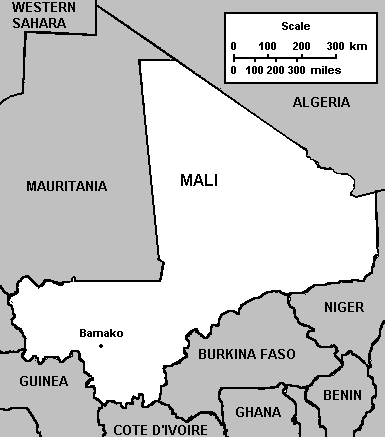


This report has been drafted under the framework of the EU-FAO Partnership Programme on sustainable forest management in African ACP countries, as part of the project on the reform of fiscal policies affecting forest management. The report examines the tax system for forestry and public spending on sustainable forest management in Mali and includes the following information:
Mali has a surface area of 1,241,238 km˛ (see Figure 1), of which 29% is occupied by forests. According to current legislation (Law-95-004), the forest estate is divided into three types of forest:
Mali’s population is essentially a rural one (72.1% of the total), of which 80% depends on primary industry. The management of forests and, more generally, of natural resources was exclusively reserved to the state by the means of quite coercive legislation (Forestry Code, State Code). Unfortunately this form of management did not succeed in curbing the degradation of forestry resources, in spite of the enormous efforts made through various forestry projects, mainly due to an imbalance between the ever-increasing needs of the population and the decreasing existing potential. This degradation was also due to the deterioration in climatic conditions. The reasons for human pressure on forestry resources are linked to social factors (runaway population growth) and particularly to economic factors. Indeed, the woodfuel sector alone represents an annual turnover of 10 billion to 14 billion FCFA, because 90% of the domestic energy resources in Mali are made up of woodfuel. Thus, the forestry sector’s contribution to GNP is estimated at 5% in monetary terms.
For some years now, forestry harvesting has become the main activity for rural populations after crop harvesting, because it provides substantial income that enables people to make ends meet.
The principle of putting back the resource that has been harvested has led the government to introduce taxes on wood harvesting, but these are derisory compared with the real value of wood.
Law 96-050 of 16 October 1996, outlining the principles of the constitution and management of forests administered by territorial communities, lays down in Article 25 that:
“The rates of tax collected for harvesting on forests
run by territorial communities are set by the competent representatives of
the territorial community following consultation with the Chamber of Agriculture.”
However, this regulation has not yet been applied due to a lack of demarcation and effective transfer of forestry areas from the state to communities. For the moment, all tax is collected by the state itself, which then pays it to the public revenue department. It is thus not possible to indicate the forest area per domain before their transfer to territorial communities.
Figure 1 A map of Mali

Note: This map has been drawn by FAO and is only an approximation.